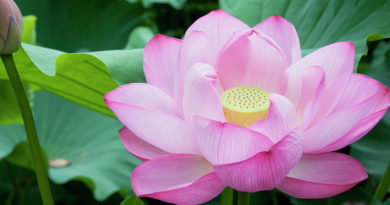USING VARIETY TO “FRESHEN UP” OUR MEDITATION – RECAPITULATION
USING VARIETY TO “FRESHEN UP” OUR MEDITATION
RECAPITULATION
Now to recapitulate what we’ve covered so far: when you practice the above method of Metta meditation, it is helpful to use easy objects at the beginning. Again Metta meditation is like lighting a fire. You start by using some paper and kindling which easily takes the flame. Once that is alight, you put on some thicker sticks, and when these are burning well, you add some bigger pieces of wood. Eventually, once the fire is established, you can put on the big pieces of fuel. When the fire is roaring you can even put on a big, wet and sappy log, and there is enough heat for that to catch light and burn too. In this simile, the “big, wet and sappy log” stands for your “enemy,” someone you find it especially hard to forgive and be kind to. This enemy is often yourself. Once Metta has been established on the easy objects, though, you will be surprised at how even the “enemy” can “take the flame” of Metta. You find, in this way, that you can actually love your enemy.
A Softening of the Mind
Something is happening. It’s a softening of the mind. The mind is turning towards this emotion of love, goodwill and care. It’s becoming selfless, not so concerned with its own needs. It’s becoming more in tune with giving, with sharing with other beings in this universe. Emotion, when it begins to be generated like this, feels very beautiful, and as you develop it more and more, that happiness of the emotion of loving-kindness gets very strong. It gets to the point that it’s self-sustaining, like a fire is self-sustaining. When it’s got enough fuel, then that’s when you don’t need to keep on with the commentary of loving-kindness. You can actually just go to its warmth, just the feeling of loving-kindness.
The feeling is usually centered around your chest, around your heart region. At least with me it is. It’s a very pleasant physical feeling, and it’s a very pleasant mental feeling as well. It’s very joyful to actually give unconditional love to another being (even one that’s imaginary). It’s an unlimited loving-kindness, without any conditions on that love. You’re just going to love that being no matter what it does. That brings out the aspect of loving-kindness which is a complete embracing of that being, with full forgiveness, without any faultfinding. When there is full loving-kindness, the “faultfinding mind” is completely transcended and there’s the “accepting mind”.
Loving-kindness is a very useful emotion to develop in meditation. To repeat: if you can develop a little bit of loving-kindness meditation like this, then you’re softening the mind. You’re softening the heart and you find that there’s not so much faultfinding. You find there’s more embracing instead. Faultfinding is being critical, seeing part of the whole — especially the part that is wrong. Whereas loving-kindness embraces the wholeness of something. By accepting even an imaginary being like the little kitten or little puppy exactly as it is, you embrace forgiveness. This is acceptance. When you can develop this acceptance toward a little puppy or a kitten or a flower, you find that when you do other meditations, even the meditation on the breath, you can be much more accepting and not so critical of the process. You won’t be so faultfinding towards the moment. You’ll find you have much more contentment. You’ll be able to embrace the moment as it is rather than being aware of so much that is wrong in the moment. The whole attitude of mind is changing. “The world is the world.” It’s what we add to the world that creates the difficulties. We can add the faults to the world or we can add acceptance to the world. It’s really up to us.
Looking at the World in a Different Way
Here we’re training the mind to look at the world in a completely different way. We can develop loving-kindness meditation so that we can regard the world through the emotion of loving-kindness, embracing and forgiveness. Because we can do that, we can also transfer that loving-kindness onto something like the breath. When we are watching the breath, we can watch it with loving-kindness, with full embracing. We nurture it just like that little seedling. (I find that if I can generate loving-kindness with breath meditation, it becomes a very, very powerful combination.) Loving-kindness avoids the faultfinding mind and gives us the ability to embrace the breath as it is, and the breath meditation is what’s going to take us into deep and peaceful states. The deep states of meditation, the Jhanas especially, are emotional states. They’re not intellectual states. If we want to develop those states we have to be able to trust in the emotions.
Sometimes I say a bit facetiously that Jhanas are feely-feely states like loving-kindness — feely, feely, feely! You’ve got to feel your way into these states, rather than think your way in. This is why, when you do loving-kindness meditation with the breath, you’re able to add that emotional sensitivity to breath meditation. You’re able to trust in that part of the mind that can feel and can delight in just the simple breath. So this is one of the reasons why it’s very handy to do Metta meditation, because it develops trust in your emotions.
Secondly of course, it gets rid of the faultfinding mind and especially the hindrance of ill will. As we discussed earlier in this section (as well as in detail in Chapter Four), ill will can be directed toward all sorts of people, but especially toward oneself. I have mentioned that it is one of the big hindrances to people attaining deep meditation. They simply don’t allow themselves to do it; or they’re too critical of themselves and therefore think they can’t do it, and this is very close to ill will. They think, “I lack self esteem”. Lack of self-confidence is right next door to ill will. So what loving-kindness does is to allow you to experience the very heights of meditation. It permits you to experience bliss, and it also gives you the confidence that you can achieve these things.
So often it’s the case that if a person thinks they can’t achieve, they won’t achieve. If a person even doubts whether they can achieve, they won’t achieve. Someone — you! — is putting the obstacle in front of yourself needlessly. So loving-kindness is like a form of encouragement. It frees you to achieve anything that is there to achieve in the world.
Again: ill will towards oneself is because of a lack of forgiveness towards oneself. That’s why near the end of a loving-kindness meditation, when the feeling is strong, you can “invite yourself into your heart”, as it were, and give yourself complete forgiveness. As it says in the Metta Sutta (Sn, 149), “… just as a mother loves her child, her only child.” This is what a mother does to her child. She loves the child, meaning she gives full forgiveness no matter what the child does in the world. She’ll always be the mother, and she’ll never abandon her child. Even animals can be like this. You know this when you’ve seen cats with kittens. The mother cat eats all of the kitten’s faeces. It licks the kittens and cleans them. The mother eats up all their dirt. It’s an amazing sort of sacrifice the mother makes for her children; that amount of forgiveness and tolerance. This is what we mean by loving-kindness — being able to accept, embrace and forgive everything. That’s the important part of Metta meditation.
We seek to develop that loving-kindness towards ourselves so completely that we reach the point where ill will is abandoned. Only then, when ill will is overcome can we give ourselves good will, can we wish ourselves well, can we allow happiness to come into us, and we can start to enjoy meditation. If there’s ill will there, it’s such a huge obstacle that it will come up at one stage or another of the meditation. It can sometimes come up towards the breath. It can sometimes come up towards the teacher. It can sometimes even come up towards your meditation cushion — “stupid cushion!”. All of that ill will is stopping you enjoying your meditation.
Loving-Kindness Is Very Beautiful
So loving-kindness meditation is very beautiful to develop, and you can develop it at any time. You don’t have to be sitting meditation. You can do it while you’re walking on the path. Develop loving-kindness in whichever way you can, but remember to try to develop it on simple objects first of all. Once more — imaginary objects are usually the best. Build it up until it’s really, really strong. When you have very, very strong loving-kindness, you can either turn to the breath if you wish (and you’ll find the breath is just so easy to watch); or if you want to, you can carry on with loving-kindness and take that into a Jhana.









